The Philippines is an archipelagic nation with over 7500 islands. In the advent of cheap flights and quick access to travel itineraries over the web, travelling has never been this easy. We already know so much about people, places, and cultures that thrive in these islands. However, very few are able to experience the enchanting beauty that exists between and beneath these islands. In this blog post, I would like to take you to the world outside of our comfort zones. I will take you to a sneak peek into the underwater kingdom and give you a glimpse of the world that I see through my diving mask.
Island Hopping in Mactan Island, Cebu
An influx of tourists are welcomed almost every day into the Mactan-Cebu International Airport. Everyone has heard the news of what a great place Mactan Island is and how it is the most fitting place to spend your vacation in. It caters to the full spectrum of travelers from affordable inns for shoestring backpackers, to the luxurious five-star hotels for the first class tourist. There is so much to experience in Mactan such as visiting the artisanal guitar crafting community in Pajac, trying out the delectable lechon (roasted whole pork) with the traditional puso (hanging rice), and of course, the most sought after island hopping in Hilutungan Channel.
Me as a Traveller
I never consider myself as the conventional tourist. I’m more of a macro-backpacker who spends the majority of my travelling time to cover only a small place and dissect into the heart of it, learning the ins and outs of a community, asking about people’s personal lives to the extent they’re still comfortable talking about, examining native flora and fauna, and learning how a typical day happens within their norms.
Recently, there is a different world outside of my comfort zone that I have learned to become a part of: the underwater world. After weeks of training and practice, I have finally learned how to dive and it is one of the best things that has ever happened to me. Through diving, I have discovered a whole new world where every day is a magic unfolding before my eyes and where there is always a realization of the truth that underwater is an environment where humans are deprived from existing (without proper equipment), but it is also where thousands and thousands of living organisms thrive. I will share with you some snaps from my second home, the coral reefs, and hopefully give you the idea about the world I see through my diving mask.
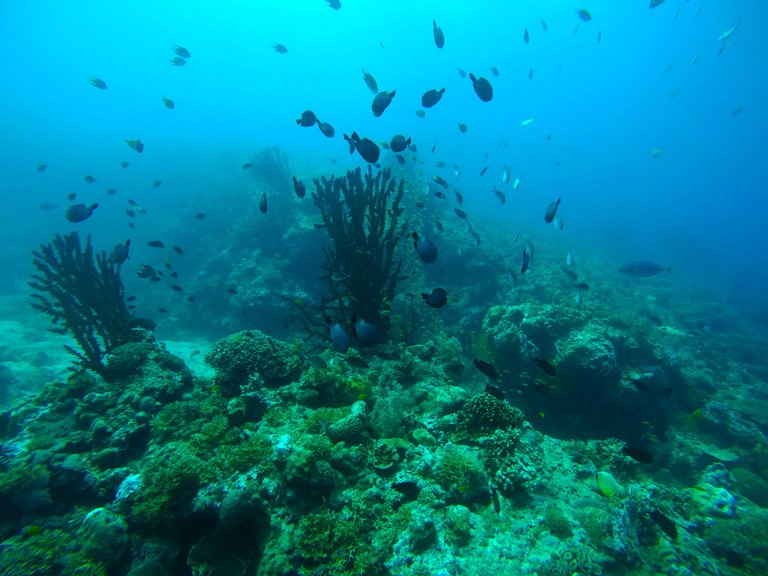
Last weekend, my colleagues and I went to an island hopping trip in the Hilutungan Channel. After months of learning how to dive, I finally forked in some cash and was able to afford my very own diving fins. I admit that diving is an expensive hobby that is way beyond my spending capacity but I have been mesmerized by the underwater world that I’d channel all resources necessary for a few minutes of encounter with my fishy friends.
The Philippines: A Biodiversity Hotspot
Our country is home to a richly diverse flora and fauna. This does not only refer to terrestrial biodiversity but also especially in marine biodiversity. I use the word “especially” because the Philippines is one of the countries in the coral triangle, along with Malaysia, Indonesia, Timor Leste, Solomon Islands, and Papua New Guinea. The coral triangle is the center of marine biodiversity in the world which means that in these six countries is where we find the richest and densest coral reefs in the entire planet. Let me first slice up some words for you. Diversity refers to the density of individual species existing in a certain place. The Philippines is ranked as the fifth most megadiverse country in the world covering both marine and terrestrial species. Marine environment refers to the sea or oceans while coral reefs refers to the ecosystems formed by accretion of coral animals.
What is a coral reef?
Corals are a wide variety of tiny animals who form underwater colonies. They produce Calcium Carbonate which makes up the basic rigid structure of coral reefs. A coral feeds and grows through the help of a microscopic algae called zooxanthellae. So in summary, a coral colony is composed of an animal, an algae, and a rock. I know most of us associate corals only as rocks or boulders but there is so much life that exists in them and that is why stepping or writing on corals’ surfaces is a big no-no. There are a lot of symbiosis and interrelationships going on in a coral reef that it can support the lives of millions of fishes and invertebrates.
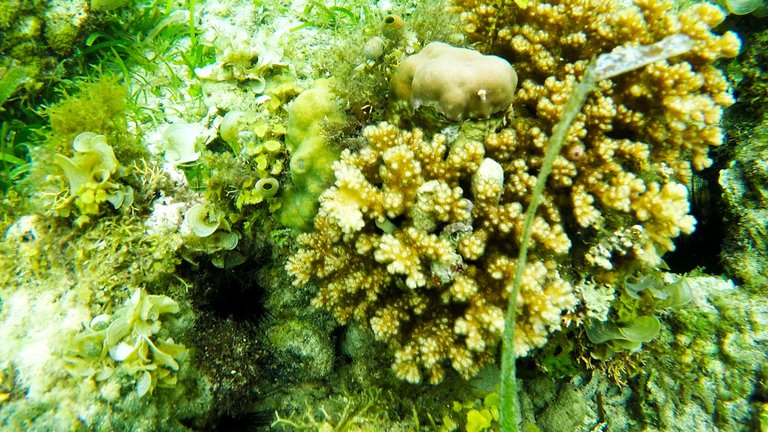
Life Below Sea Level
Below sea level is an unbelievably colorful world. Because water refracts light, objects underwater tend to lose their real colors and fade into a bluish tint. But if you know how to dive, you can get a closer encounter with these lively organisms and be able to examine their colors, patterns, and behavior. Let me introduce you to some of the ‘guys’ I have met during our island hopping tour last Saturday.
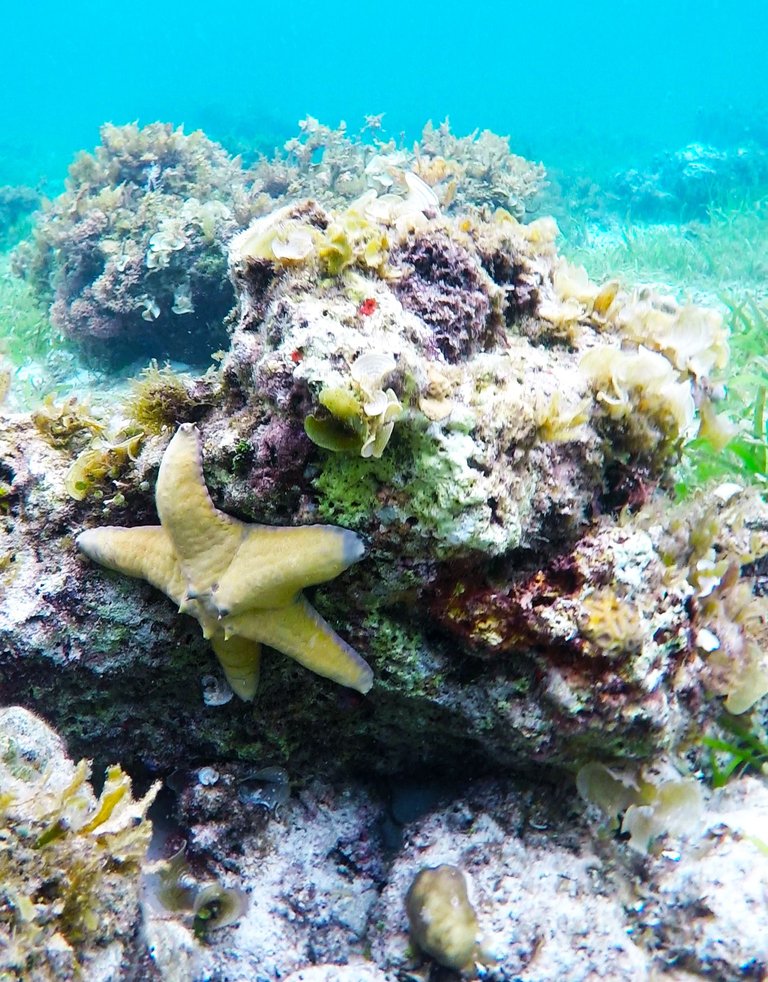
This a typical photo of a reef – a piece of boulder jutting out of the sea floor with encrusting algae and corals on it, while marine organisms, both big and small, thrive around it. The first organism I’d like you to meet is the sea star. I know we have always called it starfish but it technically is not a fish so you can give it some conscious effort and think of “sea star” every time you see a photo of this sort. They belong to the Phylum Echinodermata where organisms are commonly radially symmetrical just like their cousins the sand dollar (yes, it is a living animal!), sea urchins, and sea cucumbers.
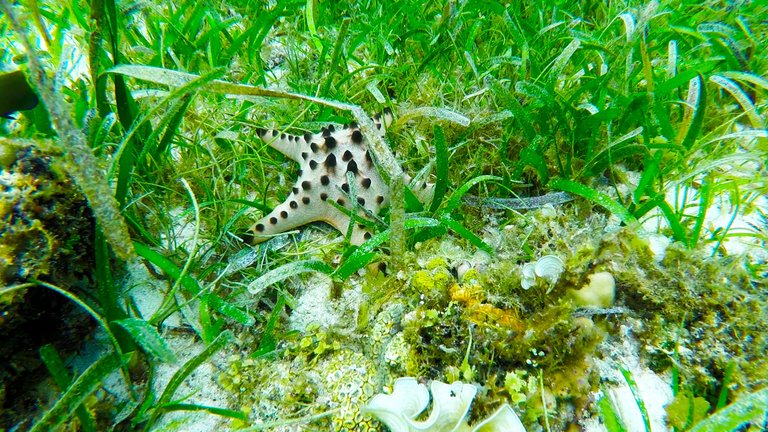
Sea stars can produce sexually by brooding eggs or asexually by forming new sea stars from a detached arm. Alternately, they can also grow new arms when one gets detached! They can move around the reef using their tiny legs located at the bottom face of their arms. They graze for prey and consume them using their mouths located at the radial center of their legs. So please, never ever pick up sea stars from the reef and make them subjects of your above water photos!
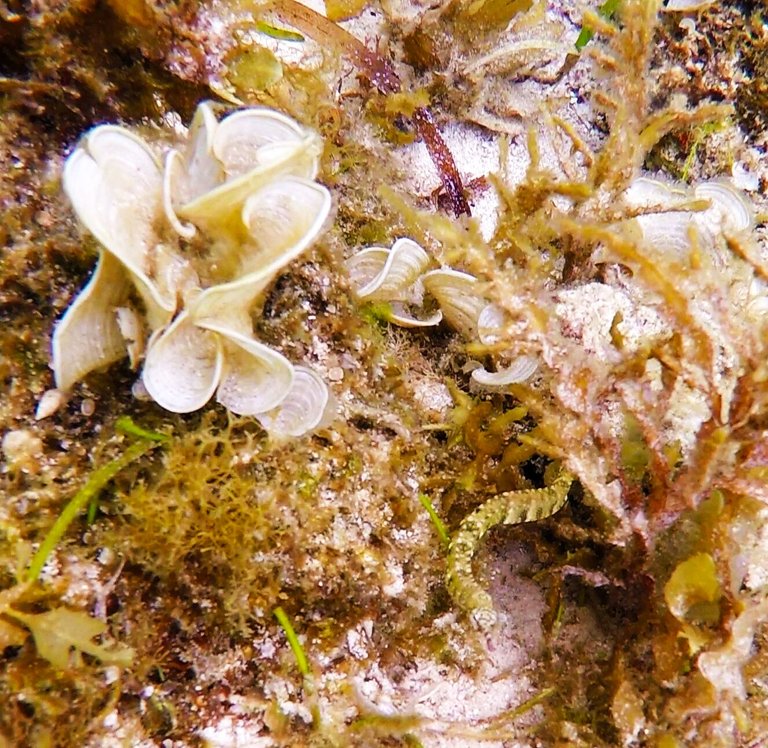
The next friend I would like to introduce you to is the pipefish. You can probably say that it is difficult to spot him in the photo (he’s the eel-shaped animal on the bottom right) and I can tell you it is also difficult to spot them in the reef. They are often camouflaged or hiding in rocks. Identified by their long protruding snout and slender elongated bodies, these fishes are the stretched-out cousins of seahorses. Just like seahorses, pipefishes are one of the few marine animals that exhibit male pregnancy. The female pipefish deposits her eggs to the male’s brood pouch where the eggs will stay and hatch. They will deliver live young once the juveniles are ready to live independently on the reef.
There are so many types of seashells in the world. We grew up thinking seashells are the tiny bits of stuff washed up on the beach that we take home and collect and make scrapbooks from. But at this point in my life, I like my seashells underwater and with the animal happily living its life on the reef. Seashells belong to the Phylum Mollusca which is the biggest phylum in the animal kingdom. Many divers like studying fishes and corals but I chose the more difficult road – I spent my marine surveying days studying molluscs!
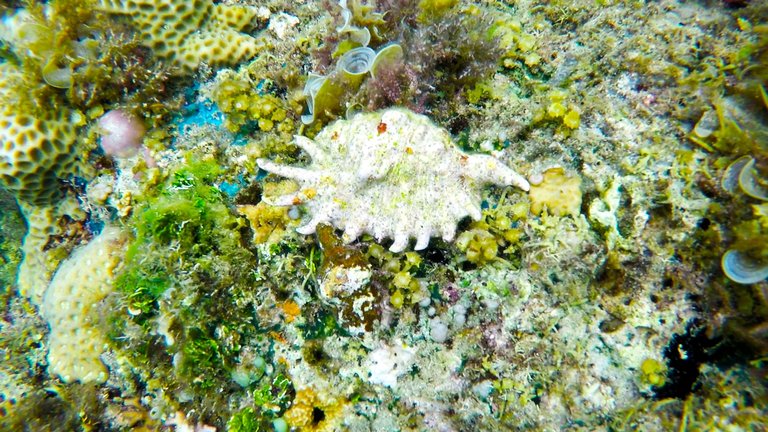
Let me introduce you to the spider conch (pronounced as conk). This guy is a type of gastropod characterized by its rigid shell and distinct spikes. At the tail-end of its spike are two notches on the edge of the shell where the eyes of the conch animal would poke out. When it senses threat, it would retract its eyes and legs inside the shell and block the opening using its operculum. The conch has a short but powerful leg that it would use to kick from underneath its shell so it can propel itself forward to attack a prey or escape a predator. I once witnessed a conch doing the leap and I was overjoyed for the rest of that dive! Conchs are important food produce and are very common in markets in Mactan Island. Even on that island hopping trip, a paddle boat went up to us selling some conch shells. My friends bought some as food while I gathered the shell remains to examine and sort into species. The one in my photo is a millipede spider conch (Lambis millipeda) which is characterized by eleven spikes compared to other conchs who only have seven spikes.
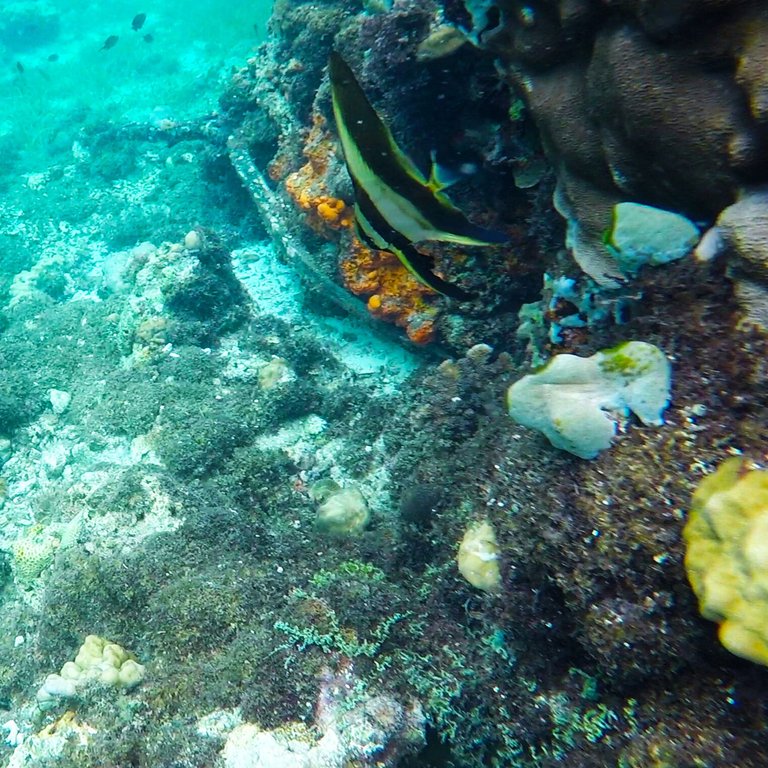
Our next fishy friend is the spadefish or also called a batfish. This one here is a juvenile characterized by its wide fin-span that extend vertically like wings. Spadefishes are often very slow moving so you get the chance to really observe them. They also identify their territories so it is common to see a spadefish in the same location every day. Juveniles differ from their adults in such a way that adults will lose the extended fins. Adults become more discoid and the body becomes more circular and almost the size of a standard dinner plate.
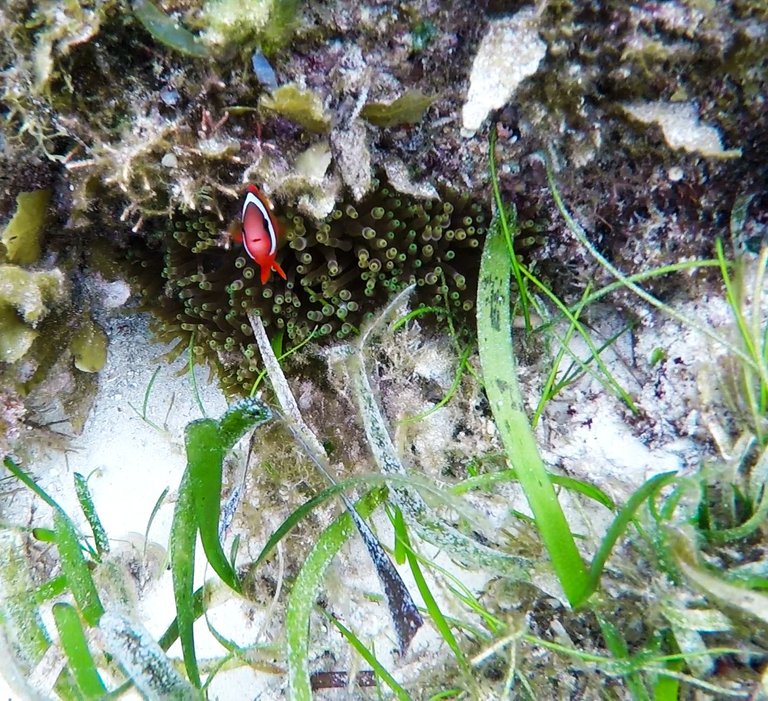
The last species that you are going to meet today is the crowd-favorite anemonefish, thanks to Disney-Pixar’s animated film. Anemonefishes are under the damselfish family, who are grouped as such because they maintain a symbiotic relationship with the invertebrate called anemone. Anemones are animals with soft tentacles and look almost like an inverted stationary version if its cousin, the jellyfish. Its tentacles contain stinging cells that serve as its protection from predators. Anemonefishes are immune to the anemone’s sting that is why they make it their homes where they can hide from predators. In return for the protection provided by the anemone, the anemonefishes would clean the anemone from sediments and debris. A give and take relationship you might say. The fish can’t live away from its anemone so the animated film is almost a biological impossibility. Anemonefishes are extremely territorial and that is why I love taking photos of them. When you approach them, they feel like they need to protect their anemone by facing you head first. That’s the perfect time to snap a photo! I wish you would’ve figured out by now that the movie Finding Nemo was called such because Nemo was an anemonefish who drifted away from his anemone.
There were so many other things I saw by freediving during our island hopping trip: a stinging cnidarian giving my leg a hug and giving me sharp stings through the bones, a big school of fusiliers swimming around to hunt, a juvenile sea cucumber moving through the sediment inch by inch, and the loveliest of all, a nudibranch!
A nudibranch is a marine snail (without the shell) with a wide-range of species all colorful and distinct. They are often referred to as the butterflies of the reef. I saw one nudibranch of the species Nembrotha kubaryana. When I saw the tiny brightly colored snail, I called the attention of @ybanezkim26, the friend who invited me to join steemit, who quickly jumped off the boat and swam to where I was. He dived down for a few seconds and then rose up to tell me how elated he was to see his first nudibranch and asked me to take a photo. However, it only took seconds for the current to drift the lovely creature away, depriving us of our photo opportunity. So I will try my best to describe how the Nembrotha kubaryana looked like and let’s hope my writing skills would work – it had a five centimeter elongated body in matte black color, bright green lines run parallel to its body, two antennas called rhinopores protrude from its head in a bright orange shade, hairy gills grow out its back in the combination of black, green and orange, the continuous foot of the animal follows the same bright orange shade as its rhinopores.

The reef is a magical place. I don’t think I can stress that enough. So I do encourage you that on your next island hopping trip, try and avoid sandy beaches and selfies, and opt more for grassy and rocky reefs and use your GoPros for photographing marine life. Make sure to take a diving mask and snorkel with you or shell out some extra pesos to rent some. You need the mask to clearly see what’s beneath you when swimming and you need the snorkel to minimize having to go upright to breathe some air. It is always easier to dive with fins but it is not a requirement. You also don’t need to be a swimmer to be able to go snorkeling. Free yourself from hesitations and fear of the water and just float on the surface with your face down and the end of your snorkel in the air. Breathe comfortably through your mouth and be conscious of the things around you. You wouldn’t want to miss a nice friendly reef shark or a fascinating cuttlefish swimming with you.
I would like to cite solid references but after months of teaching marine surveying and being a licensed Reef Check Trainer, I have come to know the basics of coral reef ecology by heart and this blog here is me speaking to you from the very bottom of my heart where a great love for Mother Nature exists.
However, I wouldn't have made this blog possible without counter-checking some facts through the following books:
Gerard Allen, Roger Steene, Paul Humann, Ned Deloach. Reef Fish Identification - Tropical Pacific. Jacksonville, Florida: New World Publications, Inc. , 2003.These books are very important to me and I browse them over and over again after every dive and throughout my venture in self-studying marine biology.
Elizabeth Wood, Michael Aw. Reef Fishes Coral and Invertebrates of The Philippines and The South China Sea. London: New Holland Publishers (UK) Ltd., 2002.
Patrick L. Colin, Charles Arneson. Tropical Pacific Invertebrates. Beverly Hills, California: Coral Reef Press, 1995.
All photos are owned by the author @xaydtrips.
Follow me for more adventures in the tropical Philippines. Thanks for your time!
Happy bubbles,
@xaydtrips
Woooow nindota oy di ganahan sad ko mag ing ani ug kabalo lang ko mulangoy hahaha
Grabe you guys are amazing gyud. @ybanezkim26's efforts in promoting high quality posts are truly commendable! Keep it up!
I'm in the right crowd gyud with @ybanezkim26 and friends kay grabe jd pagka orient niya nako to always go for quality over quantity. Salamat kaayu ninyo tanan Cebu Steemians!
Wowww thats is so beatiful and wonderful photos you have @xaydtrips.
And hello guys please support and upvote me @suararakyat 👌
Thank you so much @suararakyat! Happy steeming! 😊
I’m proud to be witnessing the beauty and wonders of the Philippines, particularly in Cebu. I’m from Leyte and I’ve been to different places in the province and also in Samar. Now that I’m here in Cebu, I can say that I am truly captivated by the beauty of our nature. The beaches, waterfalls, mountains, lake, they’re all beautiful. I hope more foreigners would take time to see what our country has in store for them. Maka-proud bai!
There are so many gems around the Philippines! And proud to have spent more than a year in Leyte, a few months in Southern Leyte, and traveling around Samar as well. You're fortunate to be Waray-waray because the region is purely a jewel. I am not native to Eastern Visayas but I consider it my second home 😊 Here's some I've written in the past:
https://steemit.com/adventure/@xaydtrips/on-the-crater-of-a-stratovolcano-mt-cabali-an-sunday-hike-life-in-the-tropics-05
https://steemit.com/adventure/@xaydtrips/uwan-uwanan-falls-an-adrenaline-pumping-secret-in-southern-leyte-life-in-the-tropics-04
I learned a lot about the underwater world through your post, @xaydtrips! I will call a star fish its true name from now on. Looking forward to your STEM posts!
Yay! Glad to hear that @thegaillery! I really enjoy teaching and I'm happy to be able to do that here in Steemit. Thanks for all the support 😊
wow @xaydtrips :) I knew it. pang curie gyud ni! Congratz xayds! Welcome to the club! :D
Thank yoi @honeyletsgo! Na inspire na jd ko to write more. Salamat ninyo and the rest of the Working Steemians!
Your good master photography
Thank you very much sir @rezatoga! Took a lot of breath-holding to take these photos 😊
Glad you enjoyed them,
@xaydtrips
Congrats on your first curie!
The nudibranch! I will take a photo next time. But seeing it first hand is enough for now.
@ybanezkim26 I can't stress this enough but I owe all of this to you. So consider the nudibranch as my first treat to you mao ikaw una nako gitawag ato. To more travels!
Yes to more travels! And more curie posts!
Congrats on your first curie! I've always wanted to try free diving but fear never fails to set in. Thanks for all the knowledge you've shared with us through this post. This makes me so proud of our team. Continue writing exceptional content. @xaydtrips
-Darryll
Thank you Darryll! I learned a lot from reading your posts here on Steemit and I'm glad that my first curie attempt is successful. I now firmly believe that quality writing is what will get you ahead here in Steemit.
Also, when you've gathered up enough courage to try freediving, don't prioritize going to depths but instead focus more on just staying midwater, being in a relaxed state, and finding comfort in breath-holding.
Interesting
I will follow you to see your future posts!
Thank you @dtubix!
nindota bai. nice pics!
thank you sir @jamiz! Yay finally nagsugat na ta diri sa steemit :D
Mao lagi. hehehe.. Nag abot ra gihapon! Sa imong post gyud ko nakabalo nga Millipede Spider Conch man diay nang saang!